
The Nakamichi 680ZX cassette deck is the premier unit in the new ZX series
and features Auto Azimuth Alignment, a scheme that automatically aligns the
record head with the play head. These decks also offer a second recording speed
of 15/16 ips with response to 15 kHz claimed and met. The front panel is black,
and the labels and designations are white, easily seen with medium level illumination.
At the right side is a vertical row of lever switches, spring-loaded for good
snap action from position to position. There's selection of EX (ferric), SX
(chrome-type) and ZX (metal) bias; 120 or 70 uS EQ; NR with and without multiplex
filter and Out for Dolby NR; Rec, Off or Play for the timer control; tape or
source monitor, power off or on, and three display functions.
The fluorescent bar display can be placed in VU, Peak Hold, or Cal mode. In VU, the attack and decay of level indications match that meter type. In addition, however, a brightened bar segment (cursor) moves in accordance to the peak levels--providing two types of information at the same time, a great idea. In Peak Hold, the display has a very fast attack and a slow decay, and the cursor decays at about one-tenth that speed to provide a helpful, longer look at the highest levels. There are a total of 48 segments for each channel, covering from -40 to +10 dB. As each segment has a separate threshold, the resolution is excellent. In Cal, which is used for AAA (Auto Azimuth Alignment) and record sensitivity adjustment, the display scaling is switched to-5 to +3 with 32 of the segments. This is an excellent utilization of bar-graph capabilities, enabling accurate and speedy calibration (discussed later).
Tape motion is logic controlled with six light-touch rocker switches with good-sized rectangular push bars. Each function has a status light just above: Red for record, green for the others. There is no flying-start recording, but a number of other things can be accomplished with the buttons and the associated logic system. For example, pushing down Rec during recording mutes the signal being recorded, which will continue to show on the display with monitor on Source. If you want a cue signal during a fast wind, pushing the pause button will shift the play head closer to the tape with Nakamichi's exclusive cam drive and will reduce wind speed to a third. Holding down the appropriate wind button at that point will reduce the wind speed to about one-fifth of nor mal for more exact cueing. From the first cue mode, it is possible to go into a program location scheme called RAMM, Random Access Music Memory. Pushing Pause a second time causes "RAMM" and "1" to appear at the left of the display. An increase in the count is obtained by successive pushes of Pause. If a decrease in count is needed, Rec is pushed. The deck will wind, counting the spaces between selections, and stop and go into play when RAMM has counted down to zero.
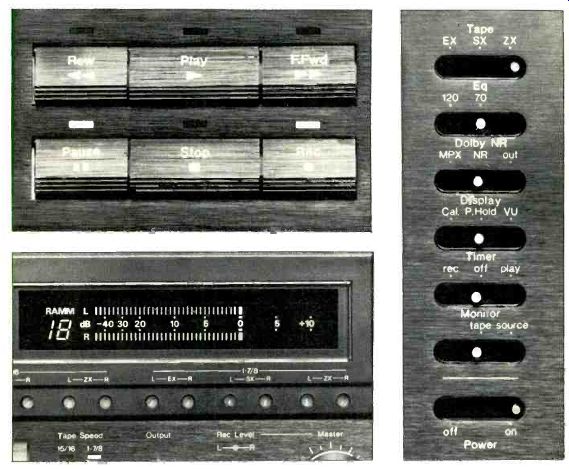
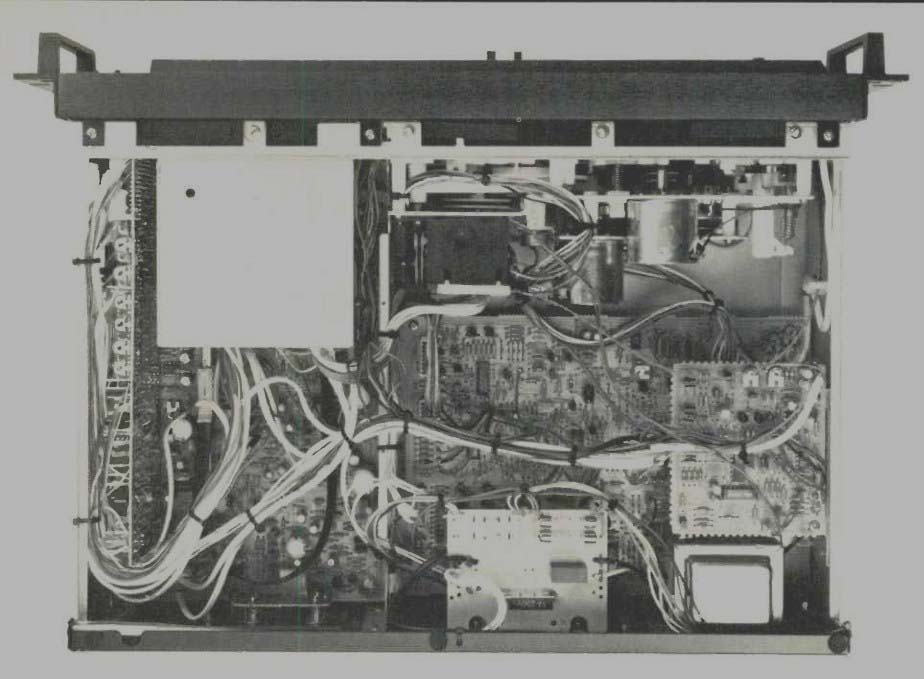
The 680ZX includes a potentially useful pitch control with a range of ±6 percent in tape play speed, up or down a musical semitone. There is a tape counter with reset and simple memory-rewind to stop at "999." Access to the three heads and dual-capstan drive for maintenance was very good, particularly with the clear door window removed. There was also ready access to head and guide adjustments with removal of a plate below the door. These are not to be diddled with by the curious, but my own view is that this approach is a good one as there are all too many decks that are not easily adjusted when service is needed. Tape speed is easily switched between 1 7/8 and 15/16 ips, with separate green indicators to call attention to the setting—although orange might have been better to emphasize the 15/16 ips setting.
--------------------
Manufacturer's Specifications
Frequency Response: 10 Hz to 22 kHz;
10 Hz to 15 kHz at 15/16 ips.
harmonic Distortion: 0.8 percent for 400 Hz at 0 dB; 1.5 percent at 15/16 ips.
S/N: 66 dBA with Dolby NR; 60 dBA at 15/16 ips.
Separation: 37 dB.
Crosstalk: 60 dB.
Erasure: 60 dB.
Input Sensitivity: Line, 50 mV.
Output Level: Line, 1000 mV; head phone, 45 mW at 8 ohms.
Flutter: 0.04 percent W rms, 0.08 per cent wtd. peak; 0.08 percent W rms,
0.14 percent wtd. peak at 15/16 ips.
Dimensions: 19 in. (482 mm) W x 5% in. (143 mm) H x 133/8 in. (340 mm) D.
Weight: 19.8 lbs. (9 kg).
Price: $1,550.00.
---------------------
Record levels are controlled with dual-concentric non-friction-coupled channel pots plus a useful master control. The channel pot knobs are the same diameter, and they can be grasped at the same time. Turning would be easier, however, with rougher knob surfaces. There is an output level control which sets the line output and the feed to the headphones (jack at the left), but it does not affect the display. Above the knobs and tape-motion switches and below the level display are six sets of record sensitivity adjustments. There are left- and right-channel set pots for EX, SX and ZX tapes both for 15/16 and 17/8 ips. Now let's take a look at the calibration scheme used in this deck.
Calibration of the Nakamichi 680ZX involves two distinct tasks: Auto Azimuth Alignment (AAA) and setting record sensitivity for optimum Dolby tracking. AAA is a closed-loop scheme with two major elements: (1) The control mechanism, which is illustrated in Fig. 1, and (2) a 400-Hz source and phase comparator with drive to the mechanism motor. It works this way: (1) The 400-Hz source is fed to the record head, (2) the output of the recorded signal from the play head is fed to the phase comparator, (3) any discrepancy in alignment results in an error-correction drive signal from the comparator to the mechanism drive motor, and (4) the record head is tilted in the direction and in the amount necessary to eliminate the error/phase discrepancy. The procedure for the user is very simple--just put the deck in record, and switch to Cal. The Play indicator flashes while the head is being adjusted, and cursors move up in each level display, indicating the results of the adjustment. When the flashing stops, the record sensitivity pots are used to set the display indication to exactly zero, most easy with the 0.25-dB resolution provided with the Cal scaling. (See the performance section of this review for the results of the tests on this innovative feature.)
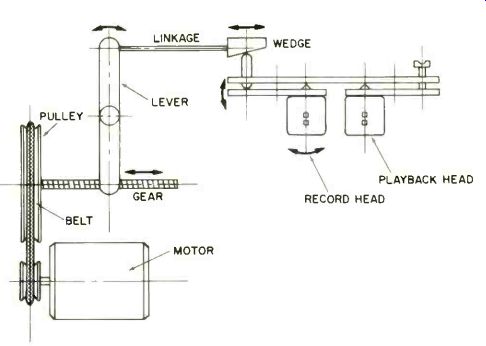
Fig. 1--Auto Azimuth Alignment control mechanism, Nakamichi 680ZX cassette
deck.
On the back panel are the line in/line out phono jacks and sockets for the optional remote control and for feeding d.c. power to the optional Nakamichi black boxes: Mike preamp, line amp, etc. Removal of the steel top and side cover revealed rugged chassis construction, actually needed for rack mounting which is possible with the 680ZX in a 5 1/4-inch space with the feet removed. All of the p.c.b.s had excellent soldering with no flux residue. Interconnections were made with wire wrap and multi-pin plugs. Adjustments were labeled, and parts were identified on both sides of the cards. There was much of quality in evidence, including the dual-capstan tape drive and the head-assembly cam-drive mechanism. One attention-catching feature was the metal drive band from the motor assembly to the record-head assembly. Examination and observation of an adjustment cycle proved that it was really quite rigid, which is necessary for consistent and accurate alignment.
Measurements
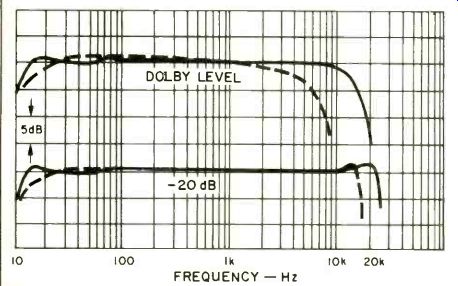
Fig. 2--Frequency responses at 1 7/8 and 15/16 (---) ips with Nakamichi EMI
tape.
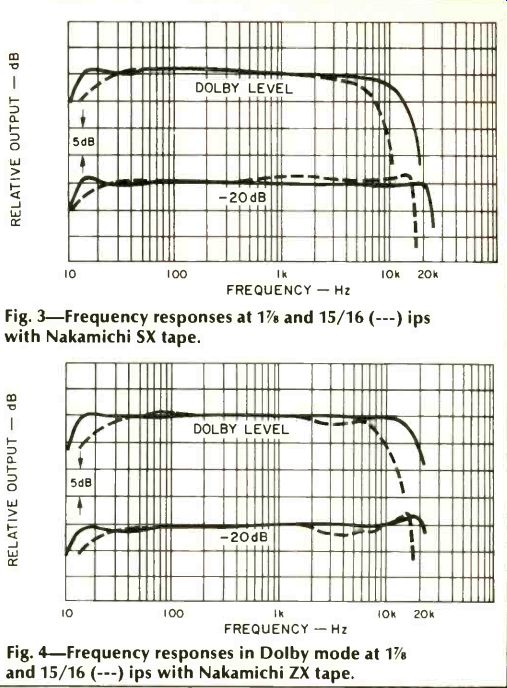
Fig. 3-Frequency responses at 1 7/8 and 15/16 (---) ips with Nakamichi SX
tape.
Fig. 4-Frequency responses in Dolby mode at 1 7/8 and 15/16 (---) ips with Nakamichi ZX tape.
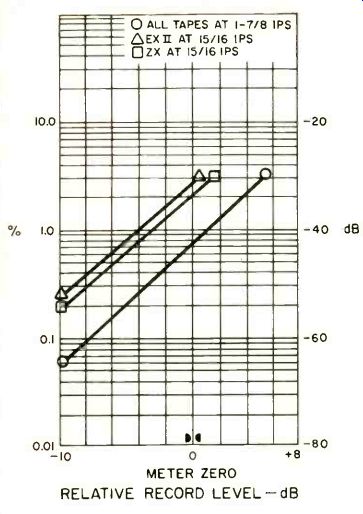
Fig. 5-Third harmonic distortion vs. level in Dolby mode at 1 kHz with Nakamichi
EXII, SX, and ZX tapes.
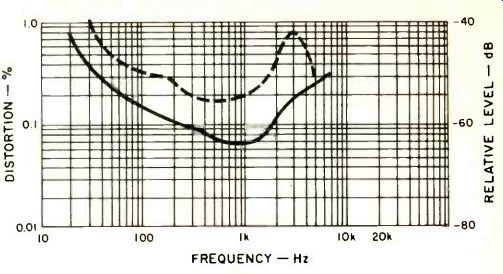
Fig. 6-Third harmonic distortion vs. frequency in Dolby mode at 10 dB below
Dolby level at 1 7/8 and 15/16 (---) ips with Nakamichi ZX tape.
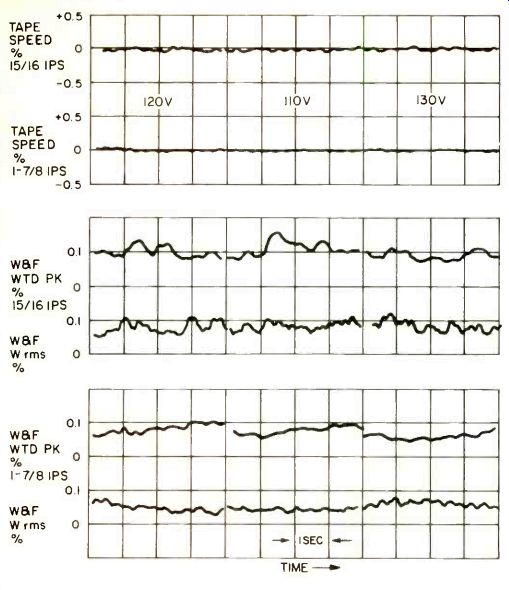
Fig. 7-- Wow and flutter (three trials) and tape play speed vs. line voltage,
Nakamichi 680ZX cassette deck.
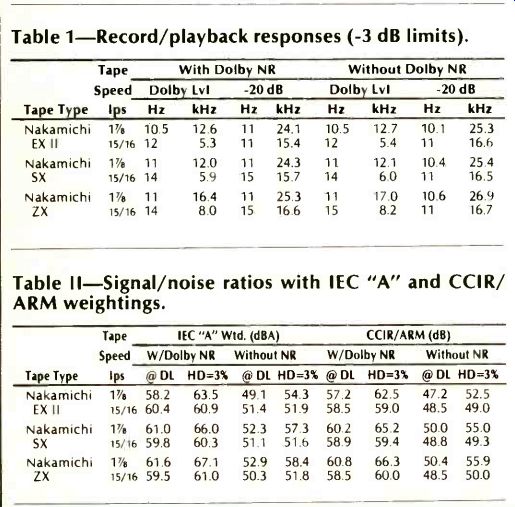
Table I--Record/playback responses (-3 dB limits).
Table II--Signal/noise ratios with IEC "A" and CCIR/ ARM weightings.
The playback responses with standard alignment tapes were within 2 dB at all frequencies for both equalizations. Playback of standard level was about a dB high, and tape play speed was 0.35 percent high. The deck was supplied with samples of Nakamichi EXII, SX and ZX (metal) tapes, and the great majority of tests were conducted with them. Some limited testing showed that TDK AD and SA, Maxell UDXL-II, and Fuji and Sony metal tapes gave the same performance, in general. The record sensitivity pots had a range of -5 to +3 dB re meter zero for all of the Nakamichi tapes. Quite a bit of time was spent evaluating the alignment scheme--to see how well it did and what its limits might be.
The test cassettes were inserted one way, and then the other, with a calibration cycle after each insertion. To pin point the accuracy of the AAA scheme, a 10-kHz tone was recorded on both channels after calibration, and the phase difference checked at this much higher frequency. The corrections made were very consistent, with B usually lagging A by 30 degrees. This error would be equivalent to only about a degree at 400 Hz, and some of the phase difference measured at 10 kHz might be from interchannel phase shifts not associated with alignment. In any event, the final results were excellent. The question of range remained, and the front-panel head adjustment was used to set in purposeful misalignment. B was made to shift ± 540 degrees relative to A, at which points the 10-kHz level in B was down more than 15 dB. The Auto Azimuth Alignment system corrected the large error in both cases within five seconds--a most impressive achievement, a capability to handle any skew ever observed. (Note that the front-panel head adjustment should normally be left alone to ensure that AAA has its full range of correction.) The phase jitter at 10 kHz was just 10 to 15 degrees at most, one of the best figures yet measured.
The record/playback responses were run at Dolby level and at 20 dB below that for both tape speeds with most of them run in Dolby mode. The 3-dB down points were deter mined for all combinations, however, with the results listed in Table I. There are a number of responses particularly worthy of note: All those at Dolby level at 1 7/8 ips extend to 12 kHz or more, all responses at -20 dB extend to 24 kHz or more, and the low end extends to 10 to 11 Hz. The responses at 15/16 ips go to at least 15.4 kHz at-20 dB in all cases and aren't that bad at 0 dB, especially with metal tape. The plots in Figs. 2 to 4 show the smoothness desired at both speeds. Dolby tracking was generally quite superior: Note the slight lift around 1 kHz for 1 7/8 in Fig. 2 and for 15/16 ips in Fig. 3. More deviation is shown with Dolby NR with metal tape (Fig. 4) at 15/16 ips, but no more than many recorders have at 1 7/8 ips. The MPX filter was 3 dB down at 16.5 kHz and 32.5 dB down at 19 kHz. Bias in the output during recording was very low.
Measurements of HDL3 were made with record levels from -10 dB (re Dolby level) to the three-percent distortion limit in Dolby mode at both speeds. The results for the three tape types at 1 7/8 ips were so close that just one line is shown in the plot of data in Fig. 5. Data were plotted for EXII and ZX at 15/16 ips; the results for SX tape fell in between. It is apparent that higher distortion is one of the prices paid for using a lower tape speed, but the plots are all perfectly straight lines, linear functions with the scaling used. HDL3 and HDLs were very low in all cases. Data on HDLI were taken at -10 dB from 20 Hz to7 kHz at 1 7/8 ips, from 30 Hz to 5 kHz at 15/16. At the higher speed, the distortion stayed lower at the extremes than is the case with most recorders. There's the expected increase in distortion with the lower speed, but the results look quite good, considering the challenges. In general, distortion figures were about 30 percent higher without Dolby NR, with less of a difference at the lowest frequencies.
Table II lists the results of signal-to-noise ratio tests using both IEC "A" and CCIR/ARM weightings. The 67.1-dBA figure with ZX tape is certainly very good, but somehow that 61.0-dBA result at 15/16 ips seems more impressive. It might appear confusing that the data at Dolby level show ratios for EXII at 15/16 ips that are higher than those obtained at the higher speed. Just keep in mind that the distortion is considerably higher at the lower speed for the same flux level. The built-in 400-Hz oscillator (413-Hz actual) had about one-per cent distortion, mostly third harmonic, adequate for the purpose of alignment and level calibration. Separation between channels was 51 dB, and crosstalk was down greater than 85 dB. Erasure of metal tape was greater than 80 dB at 1 kHz and greater than 70 dB at 100 Hz. All of these results are much better than the specifications.
Line input sensitivity was 49 mV, and the input overload point was at least 29 V. The output clipping appeared at a level equivalent to +16.3 dB meter. Sections of the master level pot tracked within a dB from maximum down more than 60 dB-excellent! The channel pots tracked within a dB for about 40 dB. The line output was 1,000 mV, exactly as specified, but it dropped to 870 mV with the standard IHF load. This is the expected result with the 2.2-kilohm source impedance of the line output. The headphone drive at 0 dB produced 50 mW into 8 ohms, plenty for all of the phones tried. The output level control tracked within a dB from maximum down for 25 dB, quite acceptable for most purposes.
The level display read somewhat high at "-40" and "-30," but was accurate from "-20" to "+10." The response was 3 dB down from less than 2 Hz to 26.9 kHz. The dynamic response in VU mode was very close to standard with a slight over shoot with the peak-level cursor with the 300-mS burst; the other bars required 350 mS for full response. In peak-response mode, the results were in accordance with IEC Stand and 268-10, and the display was just 1 dB down with a 5-kHz, 10-mS burst. Decay time for the bar display was 3 S for 20 dB, and 30 S for the peak-level cursor--all in all, an excellent combination of timings. The use of the display in the calibration process was a distinct pleasure, with appreciation of the excellent level resolution provided by the rescaling in Cal. My only criticism of the peak metering is that tests showed it to be sensitive to the polarity of pulses, with a lower level indicated with positive pulses. For the best indication of peak levels, the metering should not be polarity sensitive.
Flutter figures of 0.05 percent W rms and 0.075 percent wtd. peak were obtained at 1 7/8 ips, and 0.085 percent W rms and 0.12 percent wtd. peak at 15/16 ips-overall, basically to specification. There were higher speed variations with time at the lower speed, but they were quite minor, and there was no effect on speed from changing line voltage. Wind times for a C-60 cassette averaged 63 S. The pitch control had a range from-6.5 to +7.7 percent change in play speed, a little over a semitone (5.9 percent). All changes in tape motion were accomplished in one second or less. The deck includes a loose-loop take-up which spins the take-up hub upon insertion, but with minimal tape advance.
Use and Listening Tests
Every tape loading and unloading and maintenance task was easily handled. All switches, knobs and logic worked smoothly and without any sort of malfunction. Timer control, cueing and RAMM functions worked reliably. The pitch control was used to good advantage when recopying some tapes that were off-speed. Record sensitivity calibration was very straightforward, but Auto Azimuth Alignment was the star of this procedure, aided by the excellent proof-of-alignment display. The owner's manual has 24 pages of very good text, especially on recording levels and calibration, and its illustrations are pertinent and helpful.
I used FM to some extent for record/listening tests, but records more so, including Mike Auldridge's Blues & Blue Grass, Rob McConnell's Big Band Jazz, and a version of Strauss' Also Sprach Zarathustra. It was obvious that the Dolby tracking was really good, for there were no response jumps with switching NR in and out, but the change in noise level was obvious. The metering was excellent for setting high levels without distortion. The extended low-end response of the deck was apparent, and impressive, a number of times. The results at 15/16 ips were not great, but much better than what I thought was possible. The need for Dolby NR was certainly more obvious, and levels in the range of -5 to 0 dB generated some harshness. There were no record or pause sounds detected, and stop clicks were just out of tape noise.
With its $1550.00 price tag, the Nakamichi 680ZX cannot be purchased by many. It does offer a collection of unusual features, however, with excellent performance as well. It's a nice deck to look at, even if you just want to see what's possible with the present technology.
-Howard A. Roberson
(Adapted from: Audio magazine, Sept. 1980 )
Also see:
Nakamichi 1000ZXL Limited Cassette Deck (Sept. 1982)
Nakamichi 1000 ZXL Cassette Deck (Equip. Profile, June 1981)
Nakamichi cassette decks (Dec. 1982)
Nakamichi Model 600 Stereo Cassette Console (Sept. 1976)
Nakamichi CR-4A Cassette Deck (Aug. 1988)
Nakamichi High-Com II Noise-Reduction System (Sept. 1980)
Nakamichi 1000 DAT Recording System (Nov. 1989)
= = = =